PA-213: Urban Development in Dhaka - Environmental Problem Analysis
VerifiedAdded on 2022/02/21
|14
|4263
|41
Report
AI Summary
This report, submitted to the Department of Public Administration at the University of Dhaka, examines the critical urban environmental problems plaguing Dhaka City. It begins by defining urban development and urbanization, outlining the causes and benefits of urbanization in Bangladesh, with a specific focus on Dhaka. The report then delves into the challenges of urbanization, including housing issues, overpopulation, and the strain on infrastructure. The core of the report identifies and analyzes the dominant environmental problems in Dhaka, such as water, air, and noise pollution, detailing their causes and impacts. The report emphasizes the severity of these issues and the urgent need for effective remedies to improve the city's environmental quality and public health. The report also presents a population growth chart of Dhaka city showing the rapid population increase, adding to the existing challenges. The report concludes by highlighting the need for effective strategies to address these complex issues and ensure sustainable development in Dhaka.
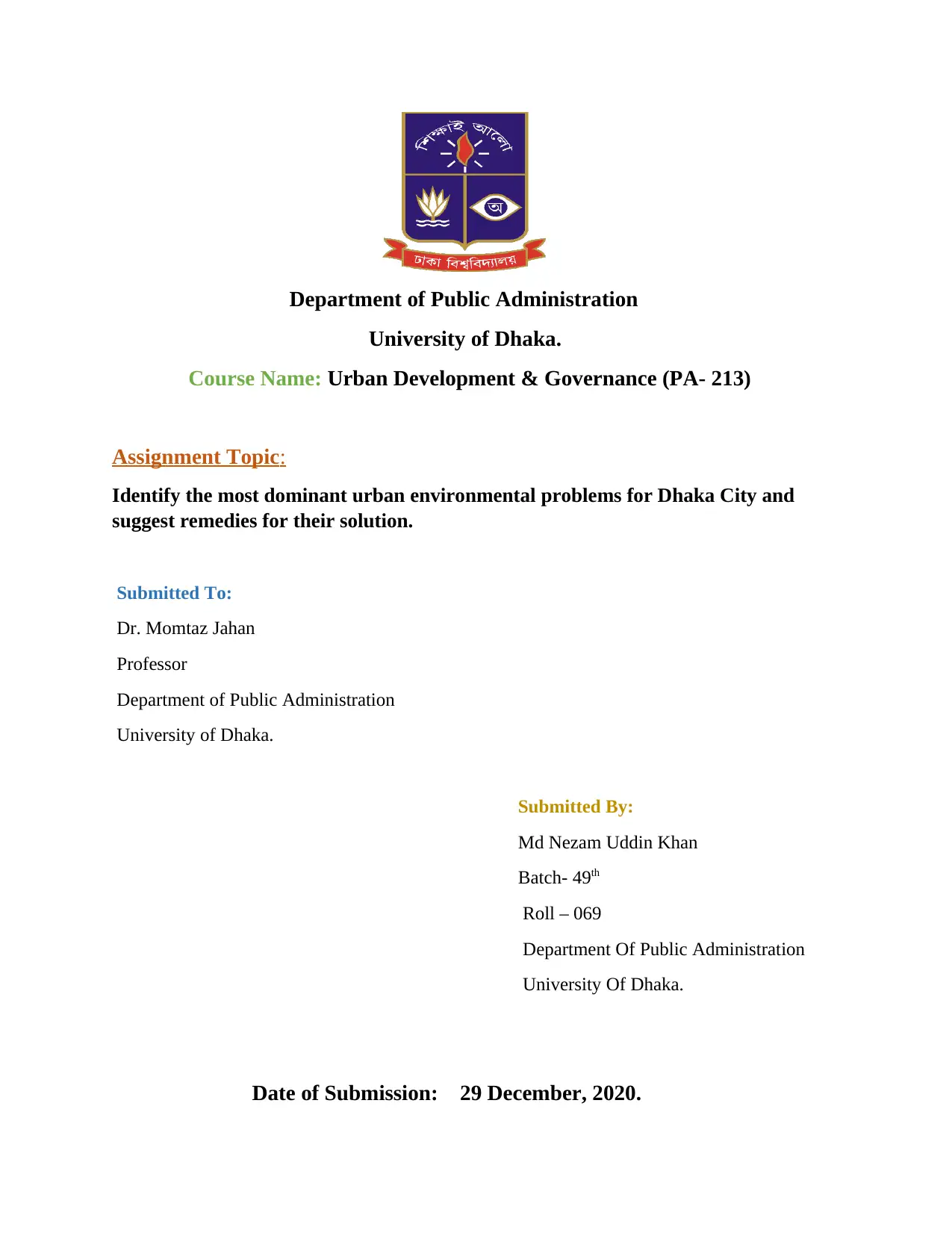
Department of Public Administration
University of Dhaka.
Course Name: Urban Development & Governance (PA- 213)
Assignment Topic:
Identify the most dominant urban environmental problems for Dhaka City and
suggest remedies for their solution.
Submitted To:
Dr. Momtaz Jahan
Professor
Department of Public Administration
University of Dhaka.
Submitted By:
Md Nezam Uddin Khan
Batch- 49th
Roll – 069
Department Of Public Administration
University Of Dhaka.
Date of Submission: 29 December, 2020.
University of Dhaka.
Course Name: Urban Development & Governance (PA- 213)
Assignment Topic:
Identify the most dominant urban environmental problems for Dhaka City and
suggest remedies for their solution.
Submitted To:
Dr. Momtaz Jahan
Professor
Department of Public Administration
University of Dhaka.
Submitted By:
Md Nezam Uddin Khan
Batch- 49th
Roll – 069
Department Of Public Administration
University Of Dhaka.
Date of Submission: 29 December, 2020.
Paraphrase This Document
Need a fresh take? Get an instant paraphrase of this document with our AI Paraphraser
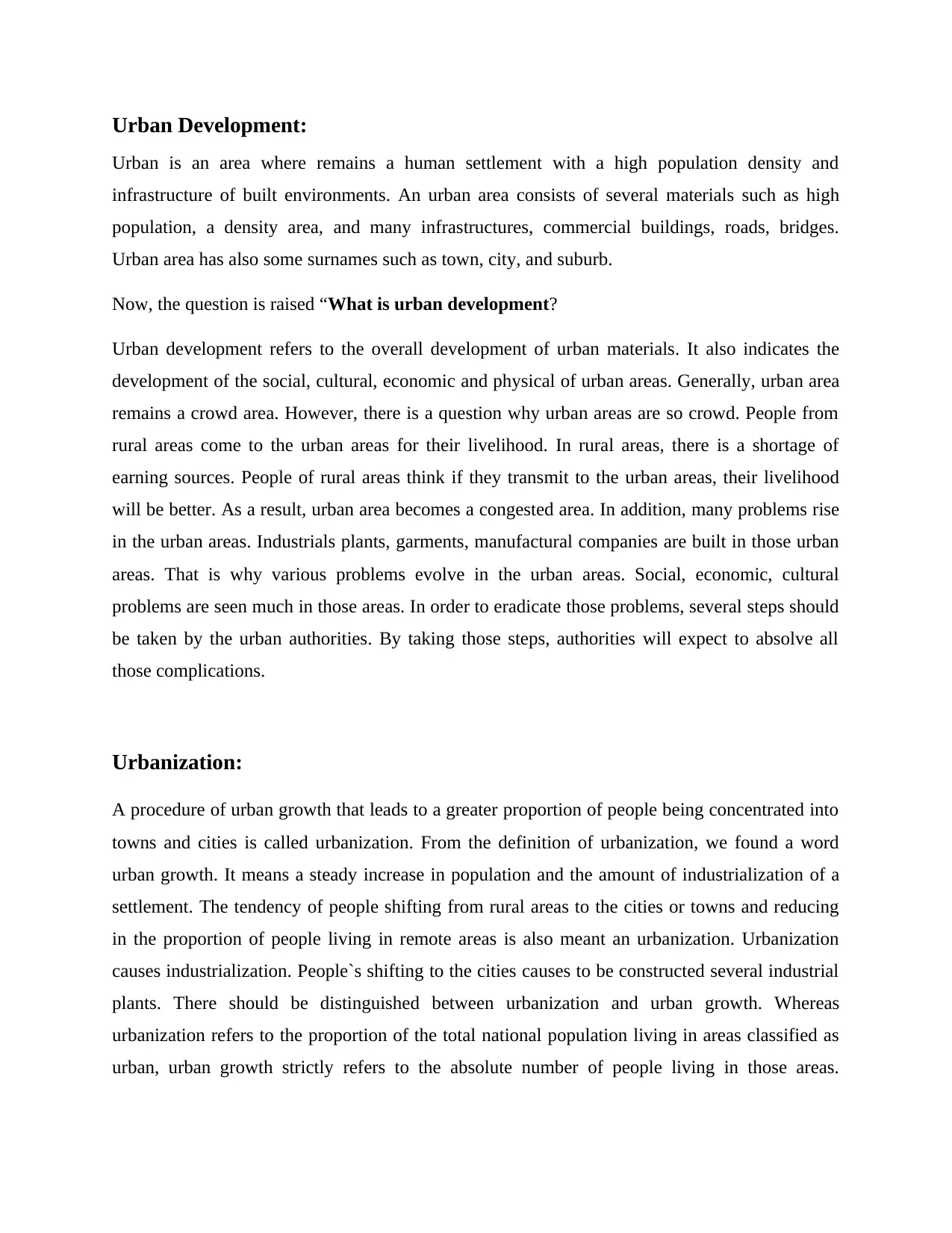
Urban Development:
Urban is an area where remains a human settlement with a high population density and
infrastructure of built environments. An urban area consists of several materials such as high
population, a density area, and many infrastructures, commercial buildings, roads, bridges.
Urban area has also some surnames such as town, city, and suburb.
Now, the question is raised “What is urban development?
Urban development refers to the overall development of urban materials. It also indicates the
development of the social, cultural, economic and physical of urban areas. Generally, urban area
remains a crowd area. However, there is a question why urban areas are so crowd. People from
rural areas come to the urban areas for their livelihood. In rural areas, there is a shortage of
earning sources. People of rural areas think if they transmit to the urban areas, their livelihood
will be better. As a result, urban area becomes a congested area. In addition, many problems rise
in the urban areas. Industrials plants, garments, manufactural companies are built in those urban
areas. That is why various problems evolve in the urban areas. Social, economic, cultural
problems are seen much in those areas. In order to eradicate those problems, several steps should
be taken by the urban authorities. By taking those steps, authorities will expect to absolve all
those complications.
Urbanization:
A procedure of urban growth that leads to a greater proportion of people being concentrated into
towns and cities is called urbanization. From the definition of urbanization, we found a word
urban growth. It means a steady increase in population and the amount of industrialization of a
settlement. The tendency of people shifting from rural areas to the cities or towns and reducing
in the proportion of people living in remote areas is also meant an urbanization. Urbanization
causes industrialization. People`s shifting to the cities causes to be constructed several industrial
plants. There should be distinguished between urbanization and urban growth. Whereas
urbanization refers to the proportion of the total national population living in areas classified as
urban, urban growth strictly refers to the absolute number of people living in those areas.
Urban is an area where remains a human settlement with a high population density and
infrastructure of built environments. An urban area consists of several materials such as high
population, a density area, and many infrastructures, commercial buildings, roads, bridges.
Urban area has also some surnames such as town, city, and suburb.
Now, the question is raised “What is urban development?
Urban development refers to the overall development of urban materials. It also indicates the
development of the social, cultural, economic and physical of urban areas. Generally, urban area
remains a crowd area. However, there is a question why urban areas are so crowd. People from
rural areas come to the urban areas for their livelihood. In rural areas, there is a shortage of
earning sources. People of rural areas think if they transmit to the urban areas, their livelihood
will be better. As a result, urban area becomes a congested area. In addition, many problems rise
in the urban areas. Industrials plants, garments, manufactural companies are built in those urban
areas. That is why various problems evolve in the urban areas. Social, economic, cultural
problems are seen much in those areas. In order to eradicate those problems, several steps should
be taken by the urban authorities. By taking those steps, authorities will expect to absolve all
those complications.
Urbanization:
A procedure of urban growth that leads to a greater proportion of people being concentrated into
towns and cities is called urbanization. From the definition of urbanization, we found a word
urban growth. It means a steady increase in population and the amount of industrialization of a
settlement. The tendency of people shifting from rural areas to the cities or towns and reducing
in the proportion of people living in remote areas is also meant an urbanization. Urbanization
causes industrialization. People`s shifting to the cities causes to be constructed several industrial
plants. There should be distinguished between urbanization and urban growth. Whereas
urbanization refers to the proportion of the total national population living in areas classified as
urban, urban growth strictly refers to the absolute number of people living in those areas.
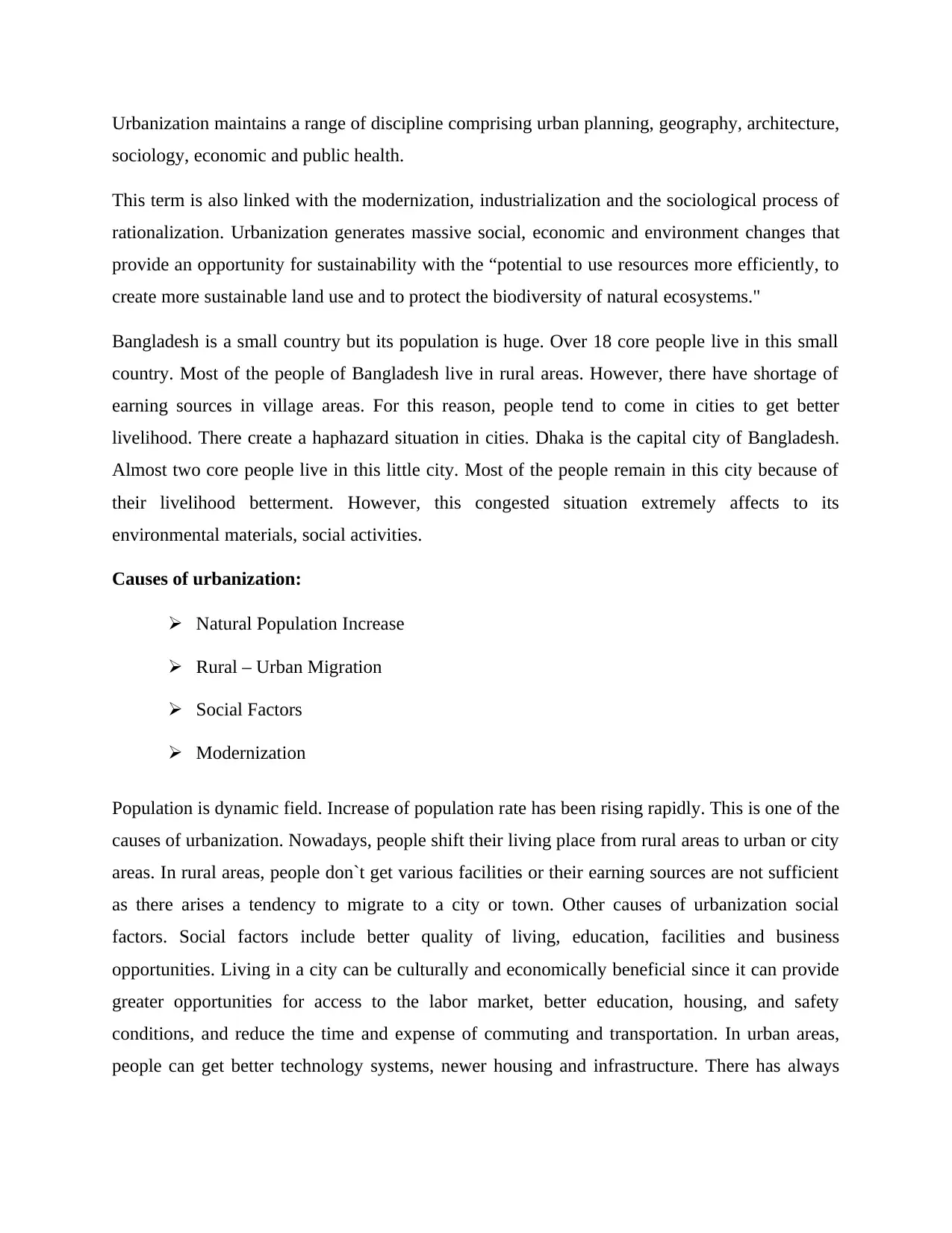
Urbanization maintains a range of discipline comprising urban planning, geography, architecture,
sociology, economic and public health.
This term is also linked with the modernization, industrialization and the sociological process of
rationalization. Urbanization generates massive social, economic and environment changes that
provide an opportunity for sustainability with the “potential to use resources more efficiently, to
create more sustainable land use and to protect the biodiversity of natural ecosystems."
Bangladesh is a small country but its population is huge. Over 18 core people live in this small
country. Most of the people of Bangladesh live in rural areas. However, there have shortage of
earning sources in village areas. For this reason, people tend to come in cities to get better
livelihood. There create a haphazard situation in cities. Dhaka is the capital city of Bangladesh.
Almost two core people live in this little city. Most of the people remain in this city because of
their livelihood betterment. However, this congested situation extremely affects to its
environmental materials, social activities.
Causes of urbanization:
Natural Population Increase
Rural – Urban Migration
Social Factors
Modernization
Population is dynamic field. Increase of population rate has been rising rapidly. This is one of the
causes of urbanization. Nowadays, people shift their living place from rural areas to urban or city
areas. In rural areas, people don`t get various facilities or their earning sources are not sufficient
as there arises a tendency to migrate to a city or town. Other causes of urbanization social
factors. Social factors include better quality of living, education, facilities and business
opportunities. Living in a city can be culturally and economically beneficial since it can provide
greater opportunities for access to the labor market, better education, housing, and safety
conditions, and reduce the time and expense of commuting and transportation. In urban areas,
people can get better technology systems, newer housing and infrastructure. There has always
sociology, economic and public health.
This term is also linked with the modernization, industrialization and the sociological process of
rationalization. Urbanization generates massive social, economic and environment changes that
provide an opportunity for sustainability with the “potential to use resources more efficiently, to
create more sustainable land use and to protect the biodiversity of natural ecosystems."
Bangladesh is a small country but its population is huge. Over 18 core people live in this small
country. Most of the people of Bangladesh live in rural areas. However, there have shortage of
earning sources in village areas. For this reason, people tend to come in cities to get better
livelihood. There create a haphazard situation in cities. Dhaka is the capital city of Bangladesh.
Almost two core people live in this little city. Most of the people remain in this city because of
their livelihood betterment. However, this congested situation extremely affects to its
environmental materials, social activities.
Causes of urbanization:
Natural Population Increase
Rural – Urban Migration
Social Factors
Modernization
Population is dynamic field. Increase of population rate has been rising rapidly. This is one of the
causes of urbanization. Nowadays, people shift their living place from rural areas to urban or city
areas. In rural areas, people don`t get various facilities or their earning sources are not sufficient
as there arises a tendency to migrate to a city or town. Other causes of urbanization social
factors. Social factors include better quality of living, education, facilities and business
opportunities. Living in a city can be culturally and economically beneficial since it can provide
greater opportunities for access to the labor market, better education, housing, and safety
conditions, and reduce the time and expense of commuting and transportation. In urban areas,
people can get better technology systems, newer housing and infrastructure. There has always
⊘ This is a preview!⊘
Do you want full access?
Subscribe today to unlock all pages.

Trusted by 1+ million students worldwide
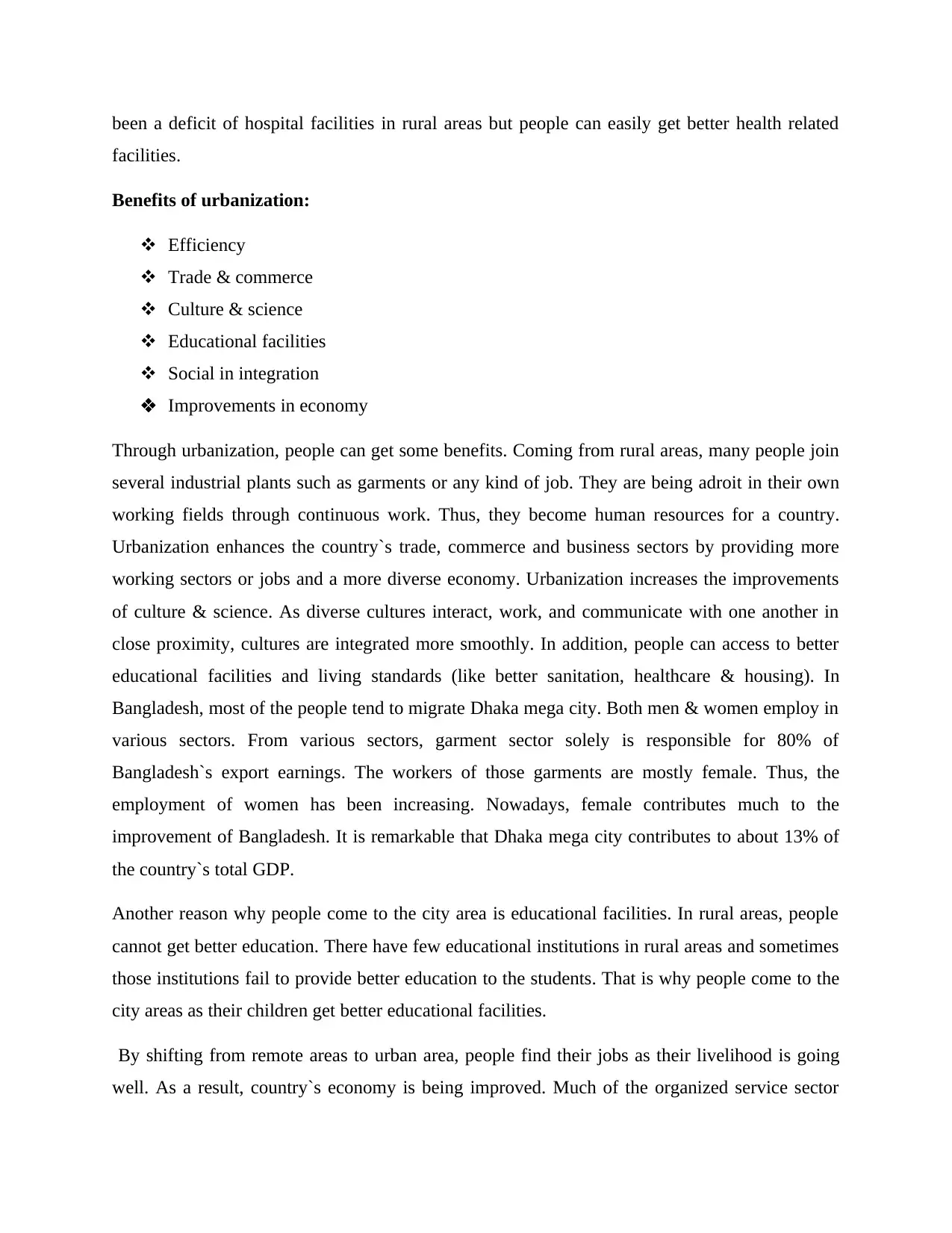
been a deficit of hospital facilities in rural areas but people can easily get better health related
facilities.
Benefits of urbanization:
Efficiency
Trade & commerce
Culture & science
Educational facilities
Social in integration
Improvements in economy
Through urbanization, people can get some benefits. Coming from rural areas, many people join
several industrial plants such as garments or any kind of job. They are being adroit in their own
working fields through continuous work. Thus, they become human resources for a country.
Urbanization enhances the country`s trade, commerce and business sectors by providing more
working sectors or jobs and a more diverse economy. Urbanization increases the improvements
of culture & science. As diverse cultures interact, work, and communicate with one another in
close proximity, cultures are integrated more smoothly. In addition, people can access to better
educational facilities and living standards (like better sanitation, healthcare & housing). In
Bangladesh, most of the people tend to migrate Dhaka mega city. Both men & women employ in
various sectors. From various sectors, garment sector solely is responsible for 80% of
Bangladesh`s export earnings. The workers of those garments are mostly female. Thus, the
employment of women has been increasing. Nowadays, female contributes much to the
improvement of Bangladesh. It is remarkable that Dhaka mega city contributes to about 13% of
the country`s total GDP.
Another reason why people come to the city area is educational facilities. In rural areas, people
cannot get better education. There have few educational institutions in rural areas and sometimes
those institutions fail to provide better education to the students. That is why people come to the
city areas as their children get better educational facilities.
By shifting from remote areas to urban area, people find their jobs as their livelihood is going
well. As a result, country`s economy is being improved. Much of the organized service sector
facilities.
Benefits of urbanization:
Efficiency
Trade & commerce
Culture & science
Educational facilities
Social in integration
Improvements in economy
Through urbanization, people can get some benefits. Coming from rural areas, many people join
several industrial plants such as garments or any kind of job. They are being adroit in their own
working fields through continuous work. Thus, they become human resources for a country.
Urbanization enhances the country`s trade, commerce and business sectors by providing more
working sectors or jobs and a more diverse economy. Urbanization increases the improvements
of culture & science. As diverse cultures interact, work, and communicate with one another in
close proximity, cultures are integrated more smoothly. In addition, people can access to better
educational facilities and living standards (like better sanitation, healthcare & housing). In
Bangladesh, most of the people tend to migrate Dhaka mega city. Both men & women employ in
various sectors. From various sectors, garment sector solely is responsible for 80% of
Bangladesh`s export earnings. The workers of those garments are mostly female. Thus, the
employment of women has been increasing. Nowadays, female contributes much to the
improvement of Bangladesh. It is remarkable that Dhaka mega city contributes to about 13% of
the country`s total GDP.
Another reason why people come to the city area is educational facilities. In rural areas, people
cannot get better education. There have few educational institutions in rural areas and sometimes
those institutions fail to provide better education to the students. That is why people come to the
city areas as their children get better educational facilities.
By shifting from remote areas to urban area, people find their jobs as their livelihood is going
well. As a result, country`s economy is being improved. Much of the organized service sector
Paraphrase This Document
Need a fresh take? Get an instant paraphrase of this document with our AI Paraphraser
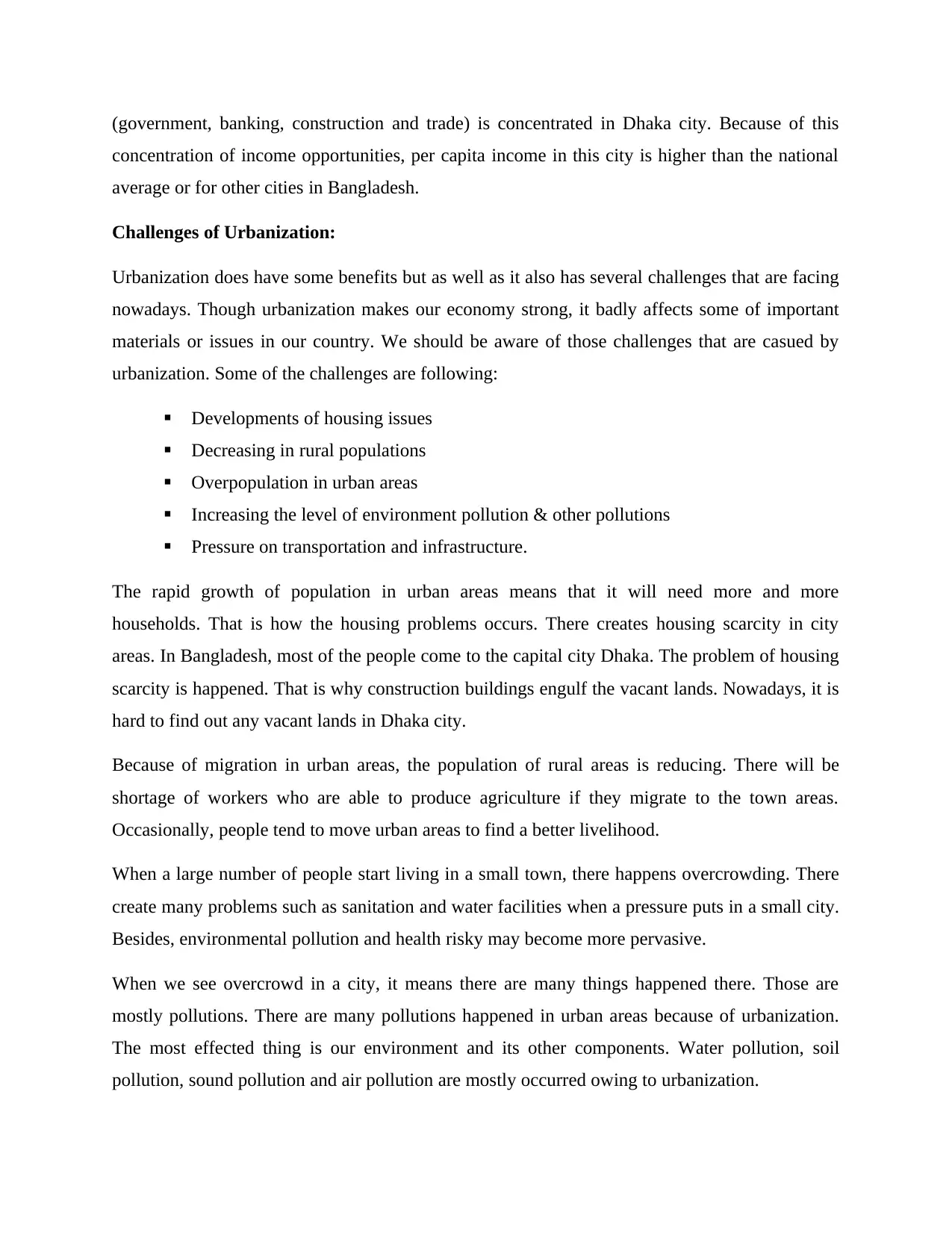
(government, banking, construction and trade) is concentrated in Dhaka city. Because of this
concentration of income opportunities, per capita income in this city is higher than the national
average or for other cities in Bangladesh.
Challenges of Urbanization:
Urbanization does have some benefits but as well as it also has several challenges that are facing
nowadays. Though urbanization makes our economy strong, it badly affects some of important
materials or issues in our country. We should be aware of those challenges that are casued by
urbanization. Some of the challenges are following:
Developments of housing issues
Decreasing in rural populations
Overpopulation in urban areas
Increasing the level of environment pollution & other pollutions
Pressure on transportation and infrastructure.
The rapid growth of population in urban areas means that it will need more and more
households. That is how the housing problems occurs. There creates housing scarcity in city
areas. In Bangladesh, most of the people come to the capital city Dhaka. The problem of housing
scarcity is happened. That is why construction buildings engulf the vacant lands. Nowadays, it is
hard to find out any vacant lands in Dhaka city.
Because of migration in urban areas, the population of rural areas is reducing. There will be
shortage of workers who are able to produce agriculture if they migrate to the town areas.
Occasionally, people tend to move urban areas to find a better livelihood.
When a large number of people start living in a small town, there happens overcrowding. There
create many problems such as sanitation and water facilities when a pressure puts in a small city.
Besides, environmental pollution and health risky may become more pervasive.
When we see overcrowd in a city, it means there are many things happened there. Those are
mostly pollutions. There are many pollutions happened in urban areas because of urbanization.
The most effected thing is our environment and its other components. Water pollution, soil
pollution, sound pollution and air pollution are mostly occurred owing to urbanization.
concentration of income opportunities, per capita income in this city is higher than the national
average or for other cities in Bangladesh.
Challenges of Urbanization:
Urbanization does have some benefits but as well as it also has several challenges that are facing
nowadays. Though urbanization makes our economy strong, it badly affects some of important
materials or issues in our country. We should be aware of those challenges that are casued by
urbanization. Some of the challenges are following:
Developments of housing issues
Decreasing in rural populations
Overpopulation in urban areas
Increasing the level of environment pollution & other pollutions
Pressure on transportation and infrastructure.
The rapid growth of population in urban areas means that it will need more and more
households. That is how the housing problems occurs. There creates housing scarcity in city
areas. In Bangladesh, most of the people come to the capital city Dhaka. The problem of housing
scarcity is happened. That is why construction buildings engulf the vacant lands. Nowadays, it is
hard to find out any vacant lands in Dhaka city.
Because of migration in urban areas, the population of rural areas is reducing. There will be
shortage of workers who are able to produce agriculture if they migrate to the town areas.
Occasionally, people tend to move urban areas to find a better livelihood.
When a large number of people start living in a small town, there happens overcrowding. There
create many problems such as sanitation and water facilities when a pressure puts in a small city.
Besides, environmental pollution and health risky may become more pervasive.
When we see overcrowd in a city, it means there are many things happened there. Those are
mostly pollutions. There are many pollutions happened in urban areas because of urbanization.
The most effected thing is our environment and its other components. Water pollution, soil
pollution, sound pollution and air pollution are mostly occurred owing to urbanization.
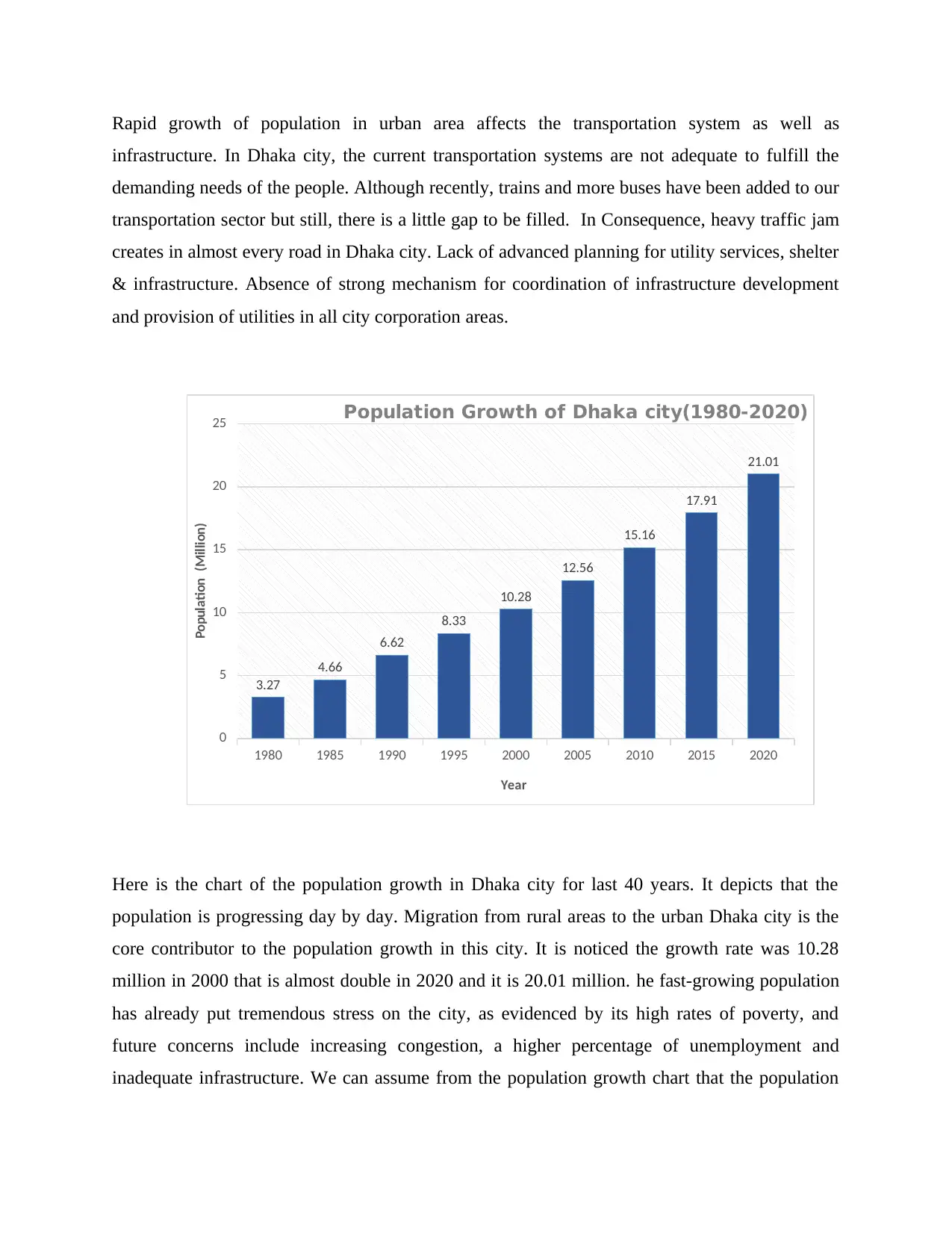
Rapid growth of population in urban area affects the transportation system as well as
infrastructure. In Dhaka city, the current transportation systems are not adequate to fulfill the
demanding needs of the people. Although recently, trains and more buses have been added to our
transportation sector but still, there is a little gap to be filled. In Consequence, heavy traffic jam
creates in almost every road in Dhaka city. Lack of advanced planning for utility services, shelter
& infrastructure. Absence of strong mechanism for coordination of infrastructure development
and provision of utilities in all city corporation areas.
1980 1985 1990 1995 2000 2005 2010 2015 2020
0
5
10
15
20
25
3.27
4.66
6.62
8.33
10.28
12.56
15.16
17.91
21.01
Population Growth of Dhaka city(1980-2020)
Year
Population (Million)
Here is the chart of the population growth in Dhaka city for last 40 years. It depicts that the
population is progressing day by day. Migration from rural areas to the urban Dhaka city is the
core contributor to the population growth in this city. It is noticed the growth rate was 10.28
million in 2000 that is almost double in 2020 and it is 20.01 million. he fast-growing population
has already put tremendous stress on the city, as evidenced by its high rates of poverty, and
future concerns include increasing congestion, a higher percentage of unemployment and
inadequate infrastructure. We can assume from the population growth chart that the population
infrastructure. In Dhaka city, the current transportation systems are not adequate to fulfill the
demanding needs of the people. Although recently, trains and more buses have been added to our
transportation sector but still, there is a little gap to be filled. In Consequence, heavy traffic jam
creates in almost every road in Dhaka city. Lack of advanced planning for utility services, shelter
& infrastructure. Absence of strong mechanism for coordination of infrastructure development
and provision of utilities in all city corporation areas.
1980 1985 1990 1995 2000 2005 2010 2015 2020
0
5
10
15
20
25
3.27
4.66
6.62
8.33
10.28
12.56
15.16
17.91
21.01
Population Growth of Dhaka city(1980-2020)
Year
Population (Million)
Here is the chart of the population growth in Dhaka city for last 40 years. It depicts that the
population is progressing day by day. Migration from rural areas to the urban Dhaka city is the
core contributor to the population growth in this city. It is noticed the growth rate was 10.28
million in 2000 that is almost double in 2020 and it is 20.01 million. he fast-growing population
has already put tremendous stress on the city, as evidenced by its high rates of poverty, and
future concerns include increasing congestion, a higher percentage of unemployment and
inadequate infrastructure. We can assume from the population growth chart that the population
⊘ This is a preview!⊘
Do you want full access?
Subscribe today to unlock all pages.

Trusted by 1+ million students worldwide
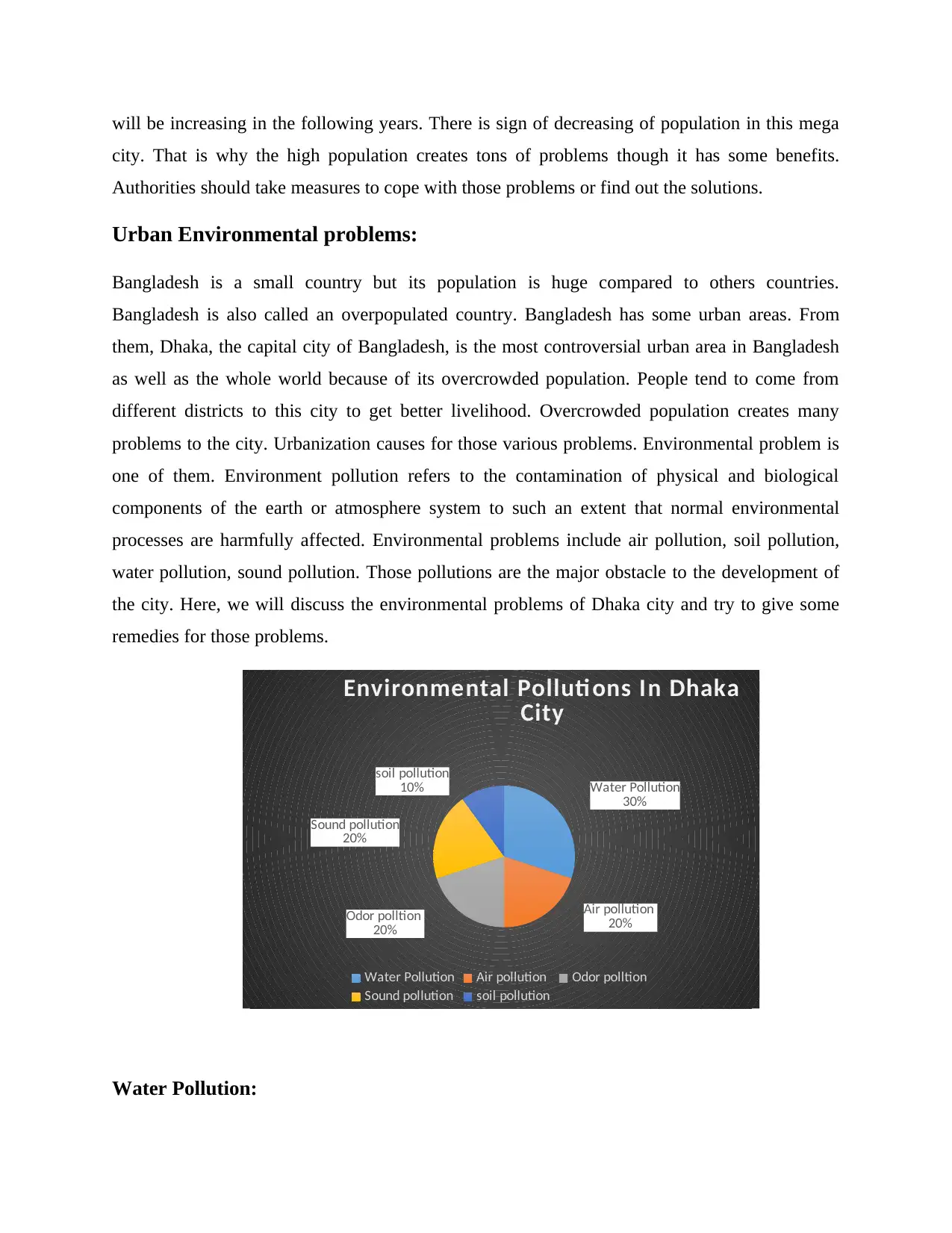
will be increasing in the following years. There is sign of decreasing of population in this mega
city. That is why the high population creates tons of problems though it has some benefits.
Authorities should take measures to cope with those problems or find out the solutions.
Urban Environmental problems:
Bangladesh is a small country but its population is huge compared to others countries.
Bangladesh is also called an overpopulated country. Bangladesh has some urban areas. From
them, Dhaka, the capital city of Bangladesh, is the most controversial urban area in Bangladesh
as well as the whole world because of its overcrowded population. People tend to come from
different districts to this city to get better livelihood. Overcrowded population creates many
problems to the city. Urbanization causes for those various problems. Environmental problem is
one of them. Environment pollution refers to the contamination of physical and biological
components of the earth or atmosphere system to such an extent that normal environmental
processes are harmfully affected. Environmental problems include air pollution, soil pollution,
water pollution, sound pollution. Those pollutions are the major obstacle to the development of
the city. Here, we will discuss the environmental problems of Dhaka city and try to give some
remedies for those problems.
Water Pollution
30%
Air pollution
20%
Odor polltion
20%
Sound pollution
20%
soil pollution
10%
Environmental Polluti ons In Dhaka
City
Water Pollution Air pollution Odor polltion
Sound pollution soil pollution
Water Pollution:
city. That is why the high population creates tons of problems though it has some benefits.
Authorities should take measures to cope with those problems or find out the solutions.
Urban Environmental problems:
Bangladesh is a small country but its population is huge compared to others countries.
Bangladesh is also called an overpopulated country. Bangladesh has some urban areas. From
them, Dhaka, the capital city of Bangladesh, is the most controversial urban area in Bangladesh
as well as the whole world because of its overcrowded population. People tend to come from
different districts to this city to get better livelihood. Overcrowded population creates many
problems to the city. Urbanization causes for those various problems. Environmental problem is
one of them. Environment pollution refers to the contamination of physical and biological
components of the earth or atmosphere system to such an extent that normal environmental
processes are harmfully affected. Environmental problems include air pollution, soil pollution,
water pollution, sound pollution. Those pollutions are the major obstacle to the development of
the city. Here, we will discuss the environmental problems of Dhaka city and try to give some
remedies for those problems.
Water Pollution
30%
Air pollution
20%
Odor polltion
20%
Sound pollution
20%
soil pollution
10%
Environmental Polluti ons In Dhaka
City
Water Pollution Air pollution Odor polltion
Sound pollution soil pollution
Water Pollution:
Paraphrase This Document
Need a fresh take? Get an instant paraphrase of this document with our AI Paraphraser
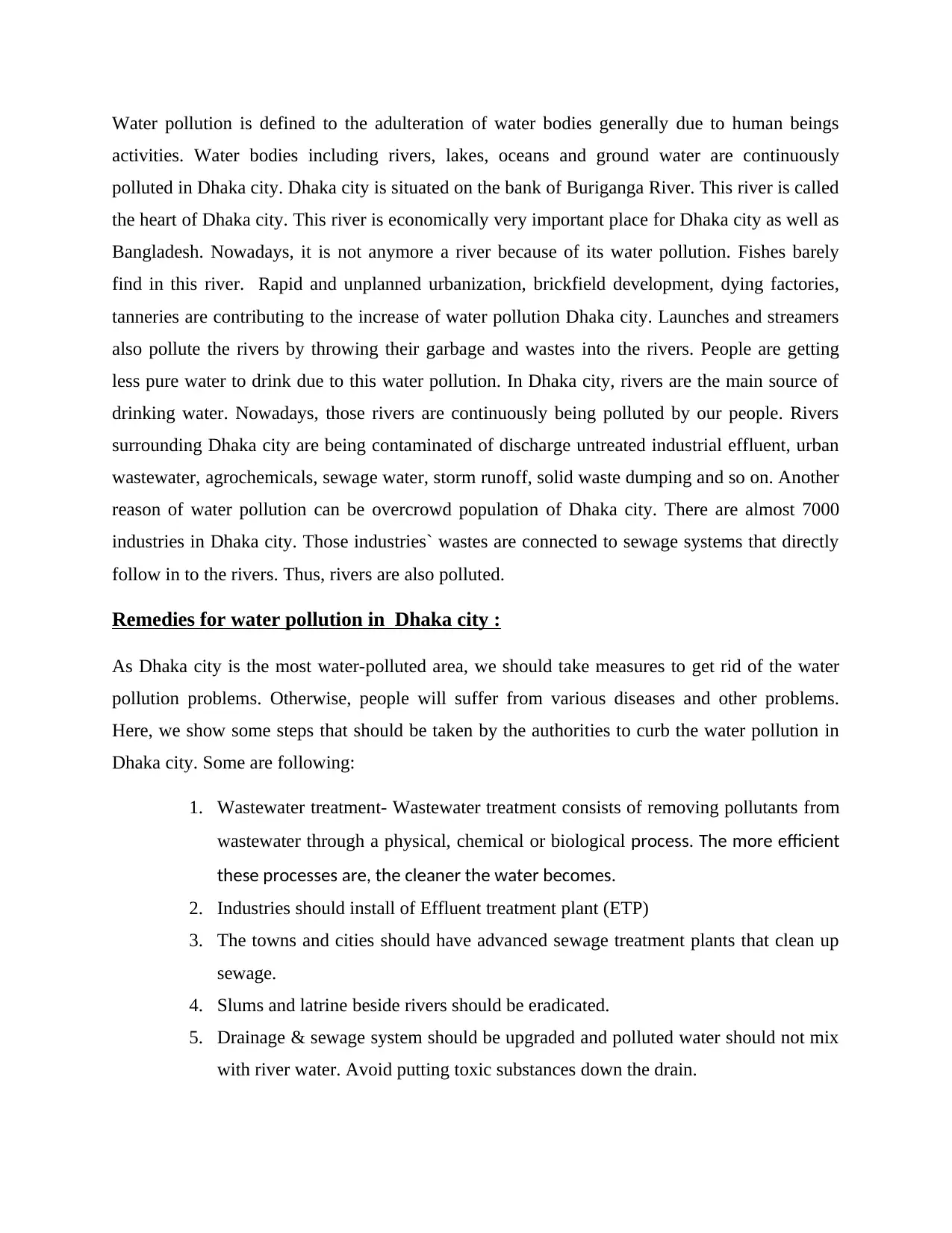
Water pollution is defined to the adulteration of water bodies generally due to human beings
activities. Water bodies including rivers, lakes, oceans and ground water are continuously
polluted in Dhaka city. Dhaka city is situated on the bank of Buriganga River. This river is called
the heart of Dhaka city. This river is economically very important place for Dhaka city as well as
Bangladesh. Nowadays, it is not anymore a river because of its water pollution. Fishes barely
find in this river. Rapid and unplanned urbanization, brickfield development, dying factories,
tanneries are contributing to the increase of water pollution Dhaka city. Launches and streamers
also pollute the rivers by throwing their garbage and wastes into the rivers. People are getting
less pure water to drink due to this water pollution. In Dhaka city, rivers are the main source of
drinking water. Nowadays, those rivers are continuously being polluted by our people. Rivers
surrounding Dhaka city are being contaminated of discharge untreated industrial effluent, urban
wastewater, agrochemicals, sewage water, storm runoff, solid waste dumping and so on. Another
reason of water pollution can be overcrowd population of Dhaka city. There are almost 7000
industries in Dhaka city. Those industries` wastes are connected to sewage systems that directly
follow in to the rivers. Thus, rivers are also polluted.
Remedies for water pollution in Dhaka city :
As Dhaka city is the most water-polluted area, we should take measures to get rid of the water
pollution problems. Otherwise, people will suffer from various diseases and other problems.
Here, we show some steps that should be taken by the authorities to curb the water pollution in
Dhaka city. Some are following:
1. Wastewater treatment- Wastewater treatment consists of removing pollutants from
wastewater through a physical, chemical or biological process. The more efficient
these processes are, the cleaner the water becomes.
2. Industries should install of Effluent treatment plant (ETP)
3. The towns and cities should have advanced sewage treatment plants that clean up
sewage.
4. Slums and latrine beside rivers should be eradicated.
5. Drainage & sewage system should be upgraded and polluted water should not mix
with river water. Avoid putting toxic substances down the drain.
activities. Water bodies including rivers, lakes, oceans and ground water are continuously
polluted in Dhaka city. Dhaka city is situated on the bank of Buriganga River. This river is called
the heart of Dhaka city. This river is economically very important place for Dhaka city as well as
Bangladesh. Nowadays, it is not anymore a river because of its water pollution. Fishes barely
find in this river. Rapid and unplanned urbanization, brickfield development, dying factories,
tanneries are contributing to the increase of water pollution Dhaka city. Launches and streamers
also pollute the rivers by throwing their garbage and wastes into the rivers. People are getting
less pure water to drink due to this water pollution. In Dhaka city, rivers are the main source of
drinking water. Nowadays, those rivers are continuously being polluted by our people. Rivers
surrounding Dhaka city are being contaminated of discharge untreated industrial effluent, urban
wastewater, agrochemicals, sewage water, storm runoff, solid waste dumping and so on. Another
reason of water pollution can be overcrowd population of Dhaka city. There are almost 7000
industries in Dhaka city. Those industries` wastes are connected to sewage systems that directly
follow in to the rivers. Thus, rivers are also polluted.
Remedies for water pollution in Dhaka city :
As Dhaka city is the most water-polluted area, we should take measures to get rid of the water
pollution problems. Otherwise, people will suffer from various diseases and other problems.
Here, we show some steps that should be taken by the authorities to curb the water pollution in
Dhaka city. Some are following:
1. Wastewater treatment- Wastewater treatment consists of removing pollutants from
wastewater through a physical, chemical or biological process. The more efficient
these processes are, the cleaner the water becomes.
2. Industries should install of Effluent treatment plant (ETP)
3. The towns and cities should have advanced sewage treatment plants that clean up
sewage.
4. Slums and latrine beside rivers should be eradicated.
5. Drainage & sewage system should be upgraded and polluted water should not mix
with river water. Avoid putting toxic substances down the drain.
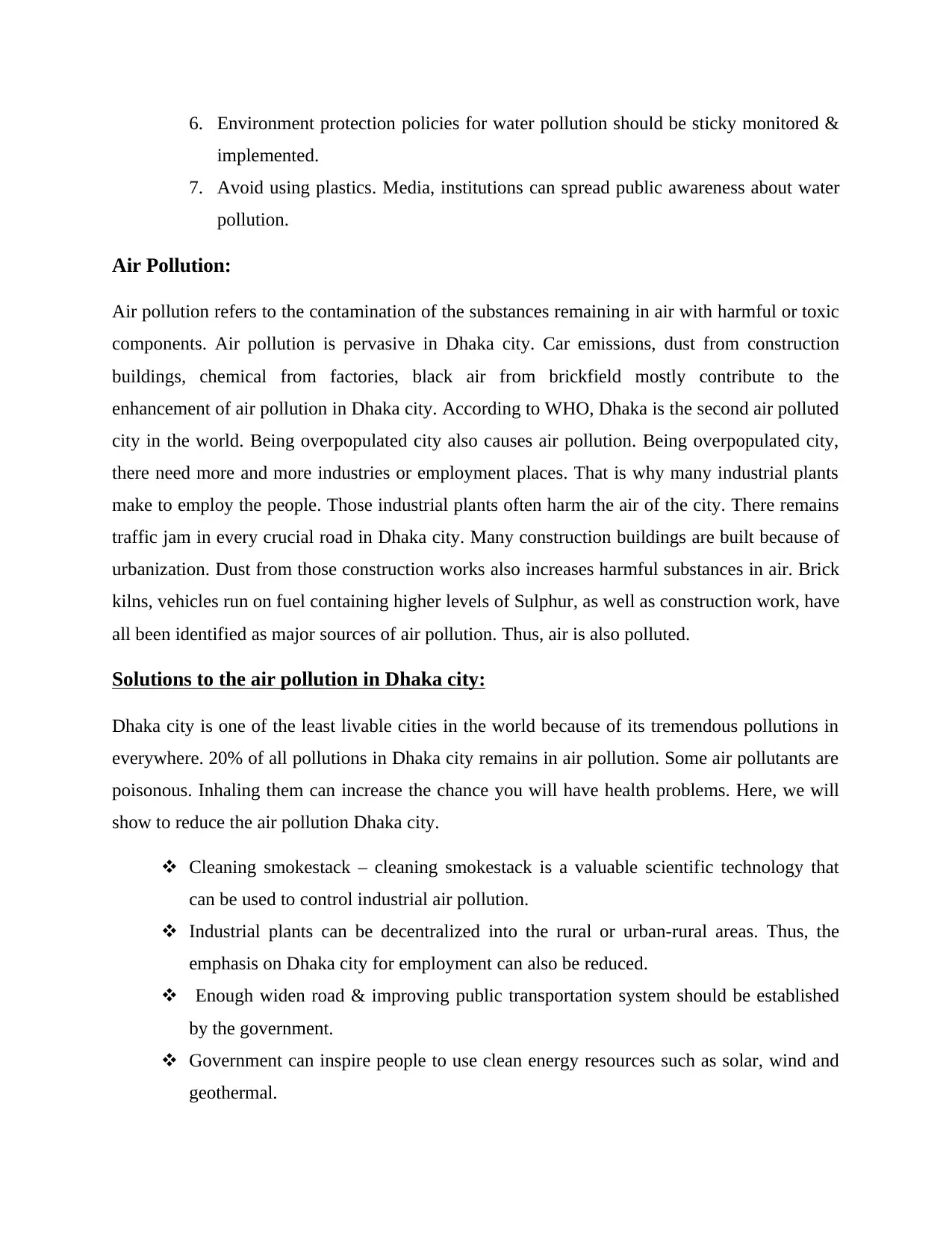
6. Environment protection policies for water pollution should be sticky monitored &
implemented.
7. Avoid using plastics. Media, institutions can spread public awareness about water
pollution.
Air Pollution:
Air pollution refers to the contamination of the substances remaining in air with harmful or toxic
components. Air pollution is pervasive in Dhaka city. Car emissions, dust from construction
buildings, chemical from factories, black air from brickfield mostly contribute to the
enhancement of air pollution in Dhaka city. According to WHO, Dhaka is the second air polluted
city in the world. Being overpopulated city also causes air pollution. Being overpopulated city,
there need more and more industries or employment places. That is why many industrial plants
make to employ the people. Those industrial plants often harm the air of the city. There remains
traffic jam in every crucial road in Dhaka city. Many construction buildings are built because of
urbanization. Dust from those construction works also increases harmful substances in air. Brick
kilns, vehicles run on fuel containing higher levels of Sulphur, as well as construction work, have
all been identified as major sources of air pollution. Thus, air is also polluted.
Solutions to the air pollution in Dhaka city:
Dhaka city is one of the least livable cities in the world because of its tremendous pollutions in
everywhere. 20% of all pollutions in Dhaka city remains in air pollution. Some air pollutants are
poisonous. Inhaling them can increase the chance you will have health problems. Here, we will
show to reduce the air pollution Dhaka city.
Cleaning smokestack – cleaning smokestack is a valuable scientific technology that
can be used to control industrial air pollution.
Industrial plants can be decentralized into the rural or urban-rural areas. Thus, the
emphasis on Dhaka city for employment can also be reduced.
Enough widen road & improving public transportation system should be established
by the government.
Government can inspire people to use clean energy resources such as solar, wind and
geothermal.
implemented.
7. Avoid using plastics. Media, institutions can spread public awareness about water
pollution.
Air Pollution:
Air pollution refers to the contamination of the substances remaining in air with harmful or toxic
components. Air pollution is pervasive in Dhaka city. Car emissions, dust from construction
buildings, chemical from factories, black air from brickfield mostly contribute to the
enhancement of air pollution in Dhaka city. According to WHO, Dhaka is the second air polluted
city in the world. Being overpopulated city also causes air pollution. Being overpopulated city,
there need more and more industries or employment places. That is why many industrial plants
make to employ the people. Those industrial plants often harm the air of the city. There remains
traffic jam in every crucial road in Dhaka city. Many construction buildings are built because of
urbanization. Dust from those construction works also increases harmful substances in air. Brick
kilns, vehicles run on fuel containing higher levels of Sulphur, as well as construction work, have
all been identified as major sources of air pollution. Thus, air is also polluted.
Solutions to the air pollution in Dhaka city:
Dhaka city is one of the least livable cities in the world because of its tremendous pollutions in
everywhere. 20% of all pollutions in Dhaka city remains in air pollution. Some air pollutants are
poisonous. Inhaling them can increase the chance you will have health problems. Here, we will
show to reduce the air pollution Dhaka city.
Cleaning smokestack – cleaning smokestack is a valuable scientific technology that
can be used to control industrial air pollution.
Industrial plants can be decentralized into the rural or urban-rural areas. Thus, the
emphasis on Dhaka city for employment can also be reduced.
Enough widen road & improving public transportation system should be established
by the government.
Government can inspire people to use clean energy resources such as solar, wind and
geothermal.
⊘ This is a preview!⊘
Do you want full access?
Subscribe today to unlock all pages.

Trusted by 1+ million students worldwide
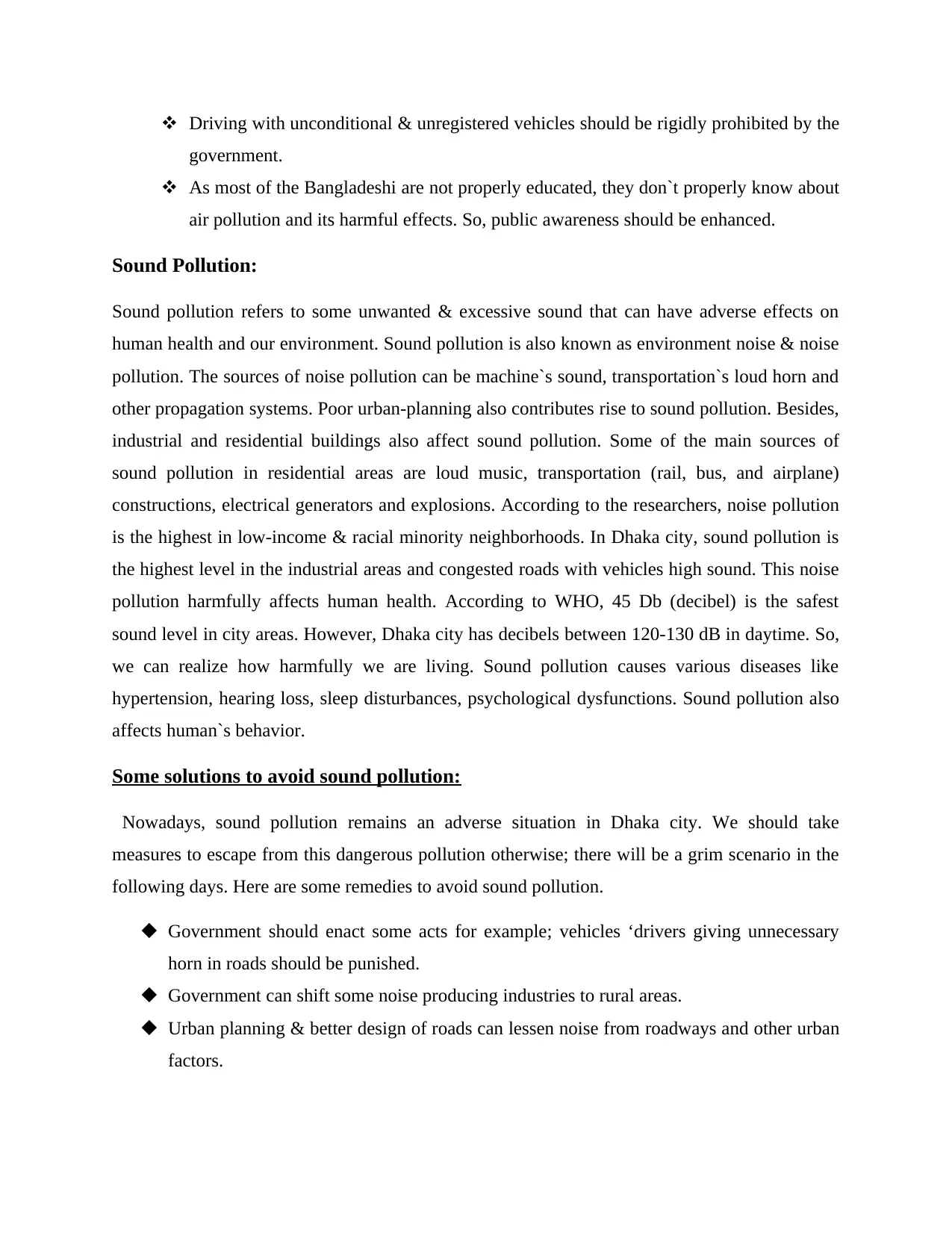
Driving with unconditional & unregistered vehicles should be rigidly prohibited by the
government.
As most of the Bangladeshi are not properly educated, they don`t properly know about
air pollution and its harmful effects. So, public awareness should be enhanced.
Sound Pollution:
Sound pollution refers to some unwanted & excessive sound that can have adverse effects on
human health and our environment. Sound pollution is also known as environment noise & noise
pollution. The sources of noise pollution can be machine`s sound, transportation`s loud horn and
other propagation systems. Poor urban-planning also contributes rise to sound pollution. Besides,
industrial and residential buildings also affect sound pollution. Some of the main sources of
sound pollution in residential areas are loud music, transportation (rail, bus, and airplane)
constructions, electrical generators and explosions. According to the researchers, noise pollution
is the highest in low-income & racial minority neighborhoods. In Dhaka city, sound pollution is
the highest level in the industrial areas and congested roads with vehicles high sound. This noise
pollution harmfully affects human health. According to WHO, 45 Db (decibel) is the safest
sound level in city areas. However, Dhaka city has decibels between 120-130 dB in daytime. So,
we can realize how harmfully we are living. Sound pollution causes various diseases like
hypertension, hearing loss, sleep disturbances, psychological dysfunctions. Sound pollution also
affects human`s behavior.
Some solutions to avoid sound pollution:
Nowadays, sound pollution remains an adverse situation in Dhaka city. We should take
measures to escape from this dangerous pollution otherwise; there will be a grim scenario in the
following days. Here are some remedies to avoid sound pollution.
Government should enact some acts for example; vehicles ‘drivers giving unnecessary
horn in roads should be punished.
Government can shift some noise producing industries to rural areas.
Urban planning & better design of roads can lessen noise from roadways and other urban
factors.
government.
As most of the Bangladeshi are not properly educated, they don`t properly know about
air pollution and its harmful effects. So, public awareness should be enhanced.
Sound Pollution:
Sound pollution refers to some unwanted & excessive sound that can have adverse effects on
human health and our environment. Sound pollution is also known as environment noise & noise
pollution. The sources of noise pollution can be machine`s sound, transportation`s loud horn and
other propagation systems. Poor urban-planning also contributes rise to sound pollution. Besides,
industrial and residential buildings also affect sound pollution. Some of the main sources of
sound pollution in residential areas are loud music, transportation (rail, bus, and airplane)
constructions, electrical generators and explosions. According to the researchers, noise pollution
is the highest in low-income & racial minority neighborhoods. In Dhaka city, sound pollution is
the highest level in the industrial areas and congested roads with vehicles high sound. This noise
pollution harmfully affects human health. According to WHO, 45 Db (decibel) is the safest
sound level in city areas. However, Dhaka city has decibels between 120-130 dB in daytime. So,
we can realize how harmfully we are living. Sound pollution causes various diseases like
hypertension, hearing loss, sleep disturbances, psychological dysfunctions. Sound pollution also
affects human`s behavior.
Some solutions to avoid sound pollution:
Nowadays, sound pollution remains an adverse situation in Dhaka city. We should take
measures to escape from this dangerous pollution otherwise; there will be a grim scenario in the
following days. Here are some remedies to avoid sound pollution.
Government should enact some acts for example; vehicles ‘drivers giving unnecessary
horn in roads should be punished.
Government can shift some noise producing industries to rural areas.
Urban planning & better design of roads can lessen noise from roadways and other urban
factors.
Paraphrase This Document
Need a fresh take? Get an instant paraphrase of this document with our AI Paraphraser
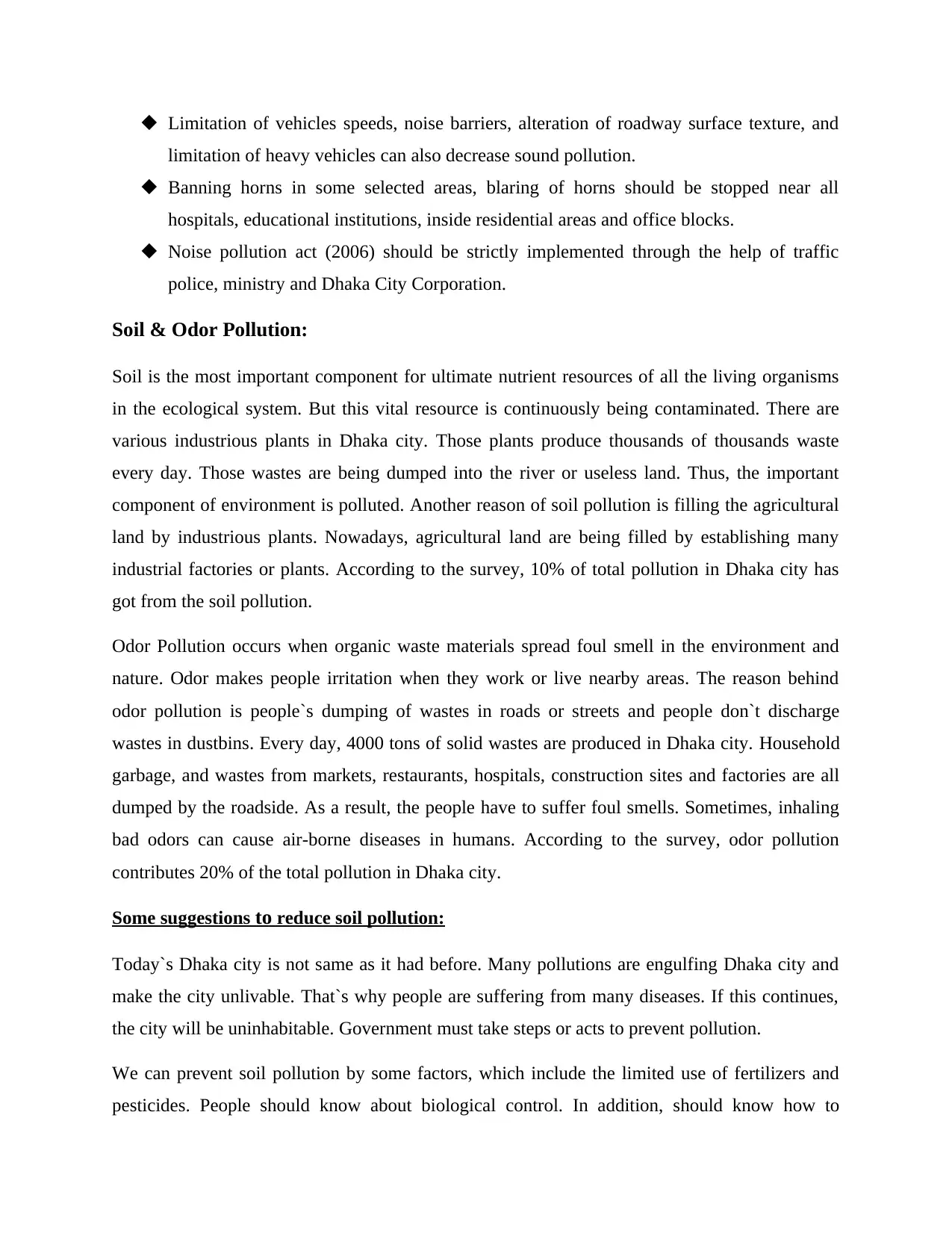
Limitation of vehicles speeds, noise barriers, alteration of roadway surface texture, and
limitation of heavy vehicles can also decrease sound pollution.
Banning horns in some selected areas, blaring of horns should be stopped near all
hospitals, educational institutions, inside residential areas and office blocks.
Noise pollution act (2006) should be strictly implemented through the help of traffic
police, ministry and Dhaka City Corporation.
Soil & Odor Pollution:
Soil is the most important component for ultimate nutrient resources of all the living organisms
in the ecological system. But this vital resource is continuously being contaminated. There are
various industrious plants in Dhaka city. Those plants produce thousands of thousands waste
every day. Those wastes are being dumped into the river or useless land. Thus, the important
component of environment is polluted. Another reason of soil pollution is filling the agricultural
land by industrious plants. Nowadays, agricultural land are being filled by establishing many
industrial factories or plants. According to the survey, 10% of total pollution in Dhaka city has
got from the soil pollution.
Odor Pollution occurs when organic waste materials spread foul smell in the environment and
nature. Odor makes people irritation when they work or live nearby areas. The reason behind
odor pollution is people`s dumping of wastes in roads or streets and people don`t discharge
wastes in dustbins. Every day, 4000 tons of solid wastes are produced in Dhaka city. Household
garbage, and wastes from markets, restaurants, hospitals, construction sites and factories are all
dumped by the roadside. As a result, the people have to suffer foul smells. Sometimes, inhaling
bad odors can cause air-borne diseases in humans. According to the survey, odor pollution
contributes 20% of the total pollution in Dhaka city.
Some suggestions to reduce soil pollution:
Today`s Dhaka city is not same as it had before. Many pollutions are engulfing Dhaka city and
make the city unlivable. That`s why people are suffering from many diseases. If this continues,
the city will be uninhabitable. Government must take steps or acts to prevent pollution.
We can prevent soil pollution by some factors, which include the limited use of fertilizers and
pesticides. People should know about biological control. In addition, should know how to
limitation of heavy vehicles can also decrease sound pollution.
Banning horns in some selected areas, blaring of horns should be stopped near all
hospitals, educational institutions, inside residential areas and office blocks.
Noise pollution act (2006) should be strictly implemented through the help of traffic
police, ministry and Dhaka City Corporation.
Soil & Odor Pollution:
Soil is the most important component for ultimate nutrient resources of all the living organisms
in the ecological system. But this vital resource is continuously being contaminated. There are
various industrious plants in Dhaka city. Those plants produce thousands of thousands waste
every day. Those wastes are being dumped into the river or useless land. Thus, the important
component of environment is polluted. Another reason of soil pollution is filling the agricultural
land by industrious plants. Nowadays, agricultural land are being filled by establishing many
industrial factories or plants. According to the survey, 10% of total pollution in Dhaka city has
got from the soil pollution.
Odor Pollution occurs when organic waste materials spread foul smell in the environment and
nature. Odor makes people irritation when they work or live nearby areas. The reason behind
odor pollution is people`s dumping of wastes in roads or streets and people don`t discharge
wastes in dustbins. Every day, 4000 tons of solid wastes are produced in Dhaka city. Household
garbage, and wastes from markets, restaurants, hospitals, construction sites and factories are all
dumped by the roadside. As a result, the people have to suffer foul smells. Sometimes, inhaling
bad odors can cause air-borne diseases in humans. According to the survey, odor pollution
contributes 20% of the total pollution in Dhaka city.
Some suggestions to reduce soil pollution:
Today`s Dhaka city is not same as it had before. Many pollutions are engulfing Dhaka city and
make the city unlivable. That`s why people are suffering from many diseases. If this continues,
the city will be uninhabitable. Government must take steps or acts to prevent pollution.
We can prevent soil pollution by some factors, which include the limited use of fertilizers and
pesticides. People should know about biological control. In addition, should know how to
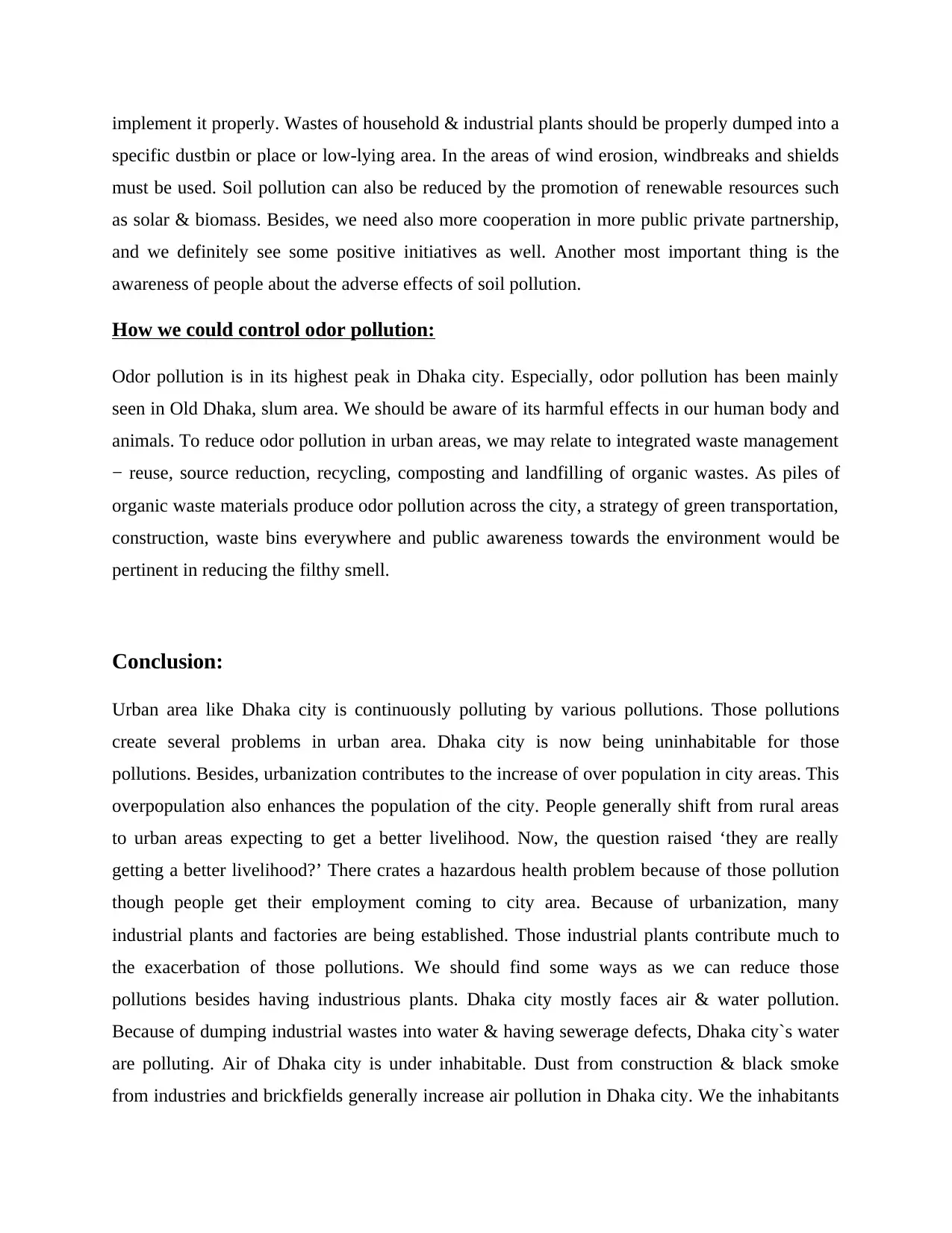
implement it properly. Wastes of household & industrial plants should be properly dumped into a
specific dustbin or place or low-lying area. In the areas of wind erosion, windbreaks and shields
must be used. Soil pollution can also be reduced by the promotion of renewable resources such
as solar & biomass. Besides, we need also more cooperation in more public private partnership,
and we definitely see some positive initiatives as well. Another most important thing is the
awareness of people about the adverse effects of soil pollution.
How we could control odor pollution:
Odor pollution is in its highest peak in Dhaka city. Especially, odor pollution has been mainly
seen in Old Dhaka, slum area. We should be aware of its harmful effects in our human body and
animals. To reduce odor pollution in urban areas, we may relate to integrated waste management
− reuse, source reduction, recycling, composting and landfilling of organic wastes. As piles of
organic waste materials produce odor pollution across the city, a strategy of green transportation,
construction, waste bins everywhere and public awareness towards the environment would be
pertinent in reducing the filthy smell.
Conclusion:
Urban area like Dhaka city is continuously polluting by various pollutions. Those pollutions
create several problems in urban area. Dhaka city is now being uninhabitable for those
pollutions. Besides, urbanization contributes to the increase of over population in city areas. This
overpopulation also enhances the population of the city. People generally shift from rural areas
to urban areas expecting to get a better livelihood. Now, the question raised ‘they are really
getting a better livelihood?’ There crates a hazardous health problem because of those pollution
though people get their employment coming to city area. Because of urbanization, many
industrial plants and factories are being established. Those industrial plants contribute much to
the exacerbation of those pollutions. We should find some ways as we can reduce those
pollutions besides having industrious plants. Dhaka city mostly faces air & water pollution.
Because of dumping industrial wastes into water & having sewerage defects, Dhaka city`s water
are polluting. Air of Dhaka city is under inhabitable. Dust from construction & black smoke
from industries and brickfields generally increase air pollution in Dhaka city. We the inhabitants
specific dustbin or place or low-lying area. In the areas of wind erosion, windbreaks and shields
must be used. Soil pollution can also be reduced by the promotion of renewable resources such
as solar & biomass. Besides, we need also more cooperation in more public private partnership,
and we definitely see some positive initiatives as well. Another most important thing is the
awareness of people about the adverse effects of soil pollution.
How we could control odor pollution:
Odor pollution is in its highest peak in Dhaka city. Especially, odor pollution has been mainly
seen in Old Dhaka, slum area. We should be aware of its harmful effects in our human body and
animals. To reduce odor pollution in urban areas, we may relate to integrated waste management
− reuse, source reduction, recycling, composting and landfilling of organic wastes. As piles of
organic waste materials produce odor pollution across the city, a strategy of green transportation,
construction, waste bins everywhere and public awareness towards the environment would be
pertinent in reducing the filthy smell.
Conclusion:
Urban area like Dhaka city is continuously polluting by various pollutions. Those pollutions
create several problems in urban area. Dhaka city is now being uninhabitable for those
pollutions. Besides, urbanization contributes to the increase of over population in city areas. This
overpopulation also enhances the population of the city. People generally shift from rural areas
to urban areas expecting to get a better livelihood. Now, the question raised ‘they are really
getting a better livelihood?’ There crates a hazardous health problem because of those pollution
though people get their employment coming to city area. Because of urbanization, many
industrial plants and factories are being established. Those industrial plants contribute much to
the exacerbation of those pollutions. We should find some ways as we can reduce those
pollutions besides having industrious plants. Dhaka city mostly faces air & water pollution.
Because of dumping industrial wastes into water & having sewerage defects, Dhaka city`s water
are polluting. Air of Dhaka city is under inhabitable. Dust from construction & black smoke
from industries and brickfields generally increase air pollution in Dhaka city. We the inhabitants
⊘ This is a preview!⊘
Do you want full access?
Subscribe today to unlock all pages.

Trusted by 1+ million students worldwide
1 out of 14
Related Documents
Your All-in-One AI-Powered Toolkit for Academic Success.
+13062052269
info@desklib.com
Available 24*7 on WhatsApp / Email
![[object Object]](/_next/static/media/star-bottom.7253800d.svg)
Unlock your academic potential
Copyright © 2020–2025 A2Z Services. All Rights Reserved. Developed and managed by ZUCOL.





